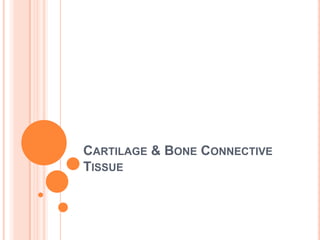
Bone and Cartilage Connective Tissues: Structure and Functions
- 1. Cartilage & Bone Connective Tissue
- 4. It is found in: the trachea, portions of the larynx, the articular cartilage on bones, epiphyseal plates, and the fetal skeleton.
- 5. It provides support through flexibility and resilience, and its extracellular matrix has a translucent appearance, with no clearly visible collagen fibers, when viewed in a microscopic section.
- 7. It can act as a shock absorber.
- 8. Located in regions of the body where a shock absorber is required such as: the intervertebral discs, the menisci of the knee, and the pubic symphysis.
- 9. It lacks a perichondrium because stress applied at the surface would quickly destroy this layer.Intervertebral Discs
- 11. It’s typically found in regions requiring a highly flexible form of support.
- 12. It can be found in: the auricle of the ear, the external auditory canal, and the epiglottis.
- 13. Elastic cartilage is surrounded by a perichondrium. Auricle
- 15. Interstitial Growth- Growth from within the cartilage itself.
- 17. The primary component is bone connective tissue, also called osseous connective tissue. They also contain connective tissue proper, cartilage connective tissue, smooth muscle tissue, fluid connective tissue, epithelial tissue, and nervous tissue.
- 18. The matrix of bone connective tissue is sturdy and rigid due to deposition of minerals in the matrix, a process called calcification.
- 20. They also protect many delicate tissues and organs from injury and trauma.
- 22. Muscles attached to the bones of the skeleton contract and exert a pull on the skeleton which then functions as a series of levers.
- 23. The bones of the skeleton can alter the direction and magnitude of the forces generated by the skeletal muscles.
- 25. Blood cells are produced in a connective tissue called red bone marrow, which is located in some spongy bone.
- 26. The locations of red bone marrow differ between children and adults. In children it is located in the spongy bone, as children mature into adults, much of the red bone marrow degenerates and turns into a fatty tissue called bone marrow.
- 28. Calcium is an essential mineral for such body functions as muscle contraction, blood clotting, and nerve impulse transmission.
- 29. Phosphate is needed for ATP utilization, among other things.
- 30. When calcium or phosphate is needed by the body, some bone connective tissue is broken down, and the minerals are released into the bloodstream.
- 32. They have an elongated, cylindrical shaft.
- 33. This is the most common bone shape.
- 34. Long Bones are found in the upper limbs and lower limbs.
- 35. They vary in size; the small bones in the fingers and toes are long bones, as are the larger tibia and fibula of the lower limb.
- 36. The shaft on a long bone is also called the diaphysis.
- 38. The external surfaces of short bones are covered by compact bone, and their interior is composed of spongy bone.
- 39. Some examples of short bones are: the carpals and tarsals.
- 40. Sesamoid bones, which are tiny, seed-shaped bones along the tendons of some muscles, are also classified as short bones.
- 41. The patella is the largest sesmoid bone.Carpals: Short Bones
- 43. These bones are composed of roughly parallel surfaces of compact bone with a layer of internally placed spongy bone.
- 44. They provide extensive surfaces for muscle attachment and protect underlying soft tissues.
- 47. Compact bone is usually forms the solid external walls of the bone.
- 48. Spongy Bone: Appears porous, like a sponge.
- 49. Forms an open lattice of narrow plates of bone, called tabeculae.
- 50. Spongy bone is located internally, primarily within the epiphyses.
- 52. Occurs within the epiphyseal plate.
- 53. Appositional Growth: Growth in diameter or thickness.
- 55. Projections from the bone surface mark the point where tendons and ligaments attach.
- 56. Sites of articulation between adjacent bones are smooth, flat areas.
- 58. First, the tensile strength of bone decreases due to a reduced rate of protein synthesis, which in turn results in decreased ability to produce the organic portion of bone matrix.
- 59. Second, bone loses calcium and other minerals. The bones of the skeleton become thinner and weaker, resulting in insufficient ossification, a condition called oseopenia.
- 60. Osteoporosis – Bone mass becomes reduced enough to compromise normal function.